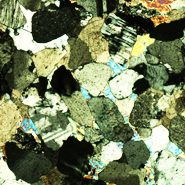Posted: 10 December 2007I
Tracking sand grains across super-continents narrows search for oil and gas
Using laser analysis techniques never previously applied to sandstone, researchers at University College Dublin have discovered that sand grains in drill cores from the Corrib gas field originated from Greenland and Canada, not from Ireland as previously thought.
According to the findings published in Geology, a leading scientific journal published by the Geological Society of America, the sand grains were transported there by ancient rivers, up to 1,000 km long, which drained a now-vanished super-continent some 230 million years ago.
“With this new geological discovery, we can highlight other areas off the western Irish seaboard where similar sandstones to those from the Corrib gas field are likely to have been laid down by these newly-discovered ancient rivers,” says Dr Shane Tyrrell from the UCD School of Geological Sciences who led the research. “And because these sandstones are proven to act as good reservoirs for hydrocarbons, this will help narrow the search for potential oil and gas accumulations off the west coast of Ireland.”
Sandstones are made up of many individual grains of different minerals, and oil or gas can be stored in the spaces between these grains. Its potential to store oil and gas is related to the area from which the individual sand grains originated.
Pictured far right: Image of Corrib gasfield sandstone taken under the microscope
The new technique applied by the UCD geologists involves sampling individual grains using a laser. The laser drills a small hole into the sand grains and a stream of gas carries particles into a mass spectrometer which is used to measure the different isotopes of lead (Pb). “By sampling with a laser we were able to measure Pb isotopes in individual grains of the mineral K-feldspar, a common component in sandstones” explains Dr Tyrrell.
“Pb isotopes in K-feldspar grains have a very distinct fingerprint which they carry with them as they are released from rocks by erosion and are transported to where they form the sandstone under investigation. By linking the sand grains to their source, it is possible to track ancient rivers and the pre-historic pattern of uplands and basins”
“Rocks from different regions on Earth can have distinct abundances of Pb isotopes so we could tell that K-feldspar sand grains from the Corrib gas field could only have originated from Greenland and Canada” says Dr Tyrrell. “Greenland and North America were, of course, much closer to Ireland 230 million years ago, as the Atlantic Ocean had not yet formed.”
“Beneath the seas surrounding our island, there are deep sedimentary basins which have been developing for the last 250 million years,” says Dr Tyrrell. “These sedimentary basins have been the focus of much research at the UCD School of Geological Sciences, as they are current targets for oil and gas exploration.” This particular study, funded by Science Foundation Ireland, is currently being expanded to investigate other sandstones in basins along the NE Atlantic margins.

